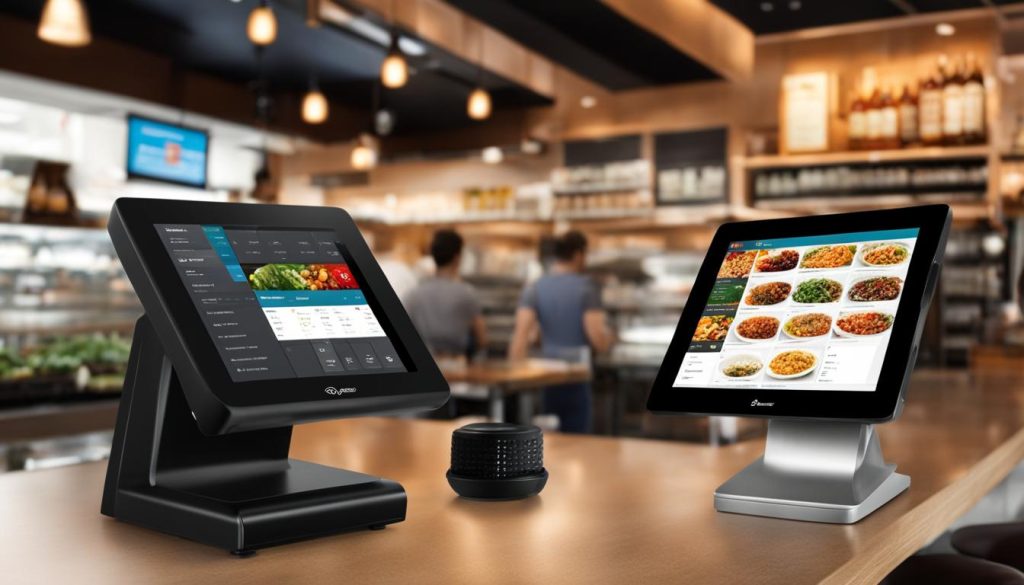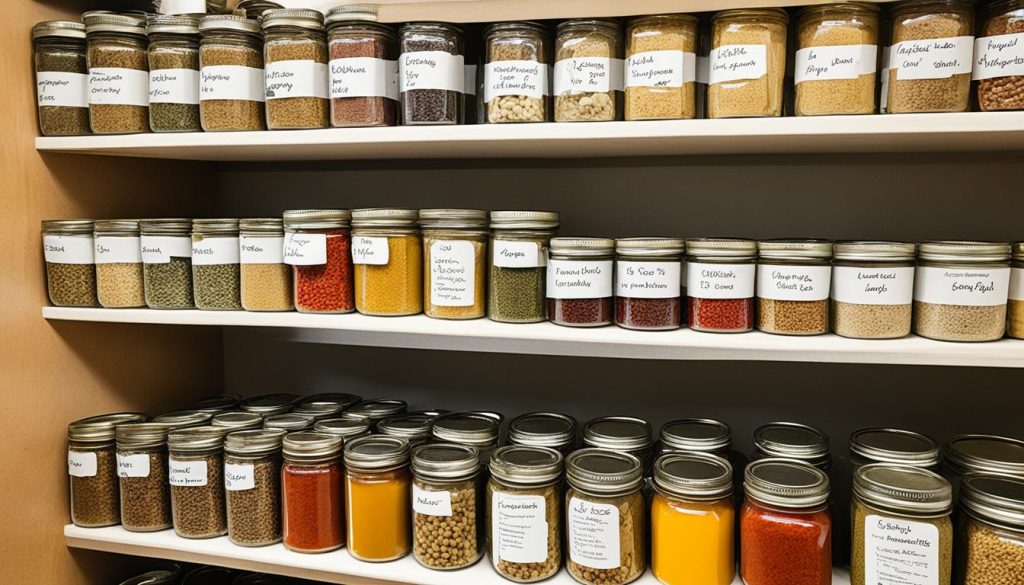Did you know that according to a study conducted by the Food and Agriculture Organization, around one-third of the food produced for human consumption is lost or wasted?
Food inventory management is crucial for restaurants to minimize waste and increase profits. By efficiently organizing and tracking inventory, restaurants can reduce spoilage, control costs, and ensure that they always have the right amount of stock on hand.
Key Takeaways:
- Effective food inventory management helps reduce waste and increase profits.
- Restaurants should categorize and organize stock, set automated reorder points, and regularly monitor stock levels.
- Using the FIFO method and tracking the sell-through rate are best practices in food inventory management.
- Restaurants should use a POS system for forecasting and order planning and train staff for efficient inventory management.
- Carrying the right amount of inventory is crucial for restaurants working with fresh ingredients.
Benefits of Restaurant Inventory Management
Effective inventory management in restaurants provides several benefits. By implementing robust inventory control measures, restaurant owners can:
- Minimize food waste and loss
- Improve vendor management by maintaining good relationships and ensuring timely deliveries
- Lower the cost of goods by optimizing stock levels and purchasing in bulk
- Increase profits through better control over inventory and reduced waste
Proper inventory management ensures the right amount of stock on hand to serve customers while avoiding spoilage and loss. This ensures customer satisfaction by delivering fresh and high-quality meals.
A well-managed inventory system also helps restaurants in vendor management. By keeping track of supplier performance and managing relationships, restaurants can ensure timely and reliable deliveries. This leads to smoother operations and customer satisfaction.
Implementing effective inventory control measures can significantly impact a restaurant’s bottom line. By reducing waste and optimizing stock levels, restaurants can increase profitability and further invest in their business growth.
Restaurant inventory management not only helps with cost control but also contributes to customer satisfaction. By consistently offering the menu items customers desire, restaurants can build a loyal customer base and drive repeat business.
Next, we will explore the best practices in restaurant inventory management to help restaurants achieve these benefits and streamline their operations.
Key Benefits of Restaurant Inventory Management
| Benefits | Keywords |
|---|---|
| Minimize food waste and loss | food waste |
| Improve vendor management | vendor management |
| Lower the cost of goods | cost of goods |
| Increase profits | increased profits |
Best Practices in Restaurant Inventory Management
Efficient restaurant inventory management involves implementing best practices to optimize stock levels, minimize waste, and ensure smooth operations. By following these practices, restaurants can enhance their categorizing stock, automate reorder points, track sell-through rates, use the FIFO method, and regularly monitor stock levels.
Categorizing and Organizing Stock
Categorizing stock is a fundamental step in effective inventory management. By organizing inventory into categories such as perishable goods, non-perishable goods, or specific food categories (e.g., dairy, produce), restaurants can easily identify and restock items. This system helps streamline the inventory control process and saves time during restocking.
Automated Reorder Points
Setting automated reorder points is essential to maintain optimal stock levels. By utilizing inventory management systems or software, restaurants can automatically generate purchase orders or alerts when stock quantities reach a predefined threshold. This practice ensures that the right amount of stock is maintained without excessive overstocking or stockouts, improving efficiency and reducing inventory holding costs.
Tracking Sell-Through Rates
Tracking the sell-through rate provides valuable insights into popular and slow-moving items. By monitoring how quickly items are sold, restaurants can identify top-selling menu items and adjust their inventory levels accordingly. This data helps optimize stock allocation to meet customer demand and reduce the risk of overstocking or understocking.
Using the FIFO Method
The FIFO (First-In, First-Out) method is a commonly used practice to ensure the use of oldest stock first. By rotating stock based on expiration or production dates, restaurants can minimize the risk of spoilage or expired products. It also helps maintain product quality and avoids potential health and safety issues associated with expired goods. Incorporating the FIFO method into inventory management improves overall food safety and prevents financial loss.
Regular Stock Monitoring
Consistent monitoring of stock levels is essential for effective inventory management. By regularly reviewing stock records, restaurants can identify trends, anticipate demand fluctuations, and proactively adjust their ordering strategies. Regular stock monitoring also detects discrepancies, such as theft or inaccurate tracking, ensuring inventory accuracy and preventing potential profit loss.
Implementing these best practices in restaurant inventory management improves organizational efficiency, reduces waste, and enhances profitability. By categorizing stock, setting automated reorder points, tracking sell-through rates, using the FIFO method, and regularly monitoring stock levels, restaurants can optimize their inventory management processes and ensure smooth operations.
| Best Practices | Benefits |
|---|---|
| Categorizing and organizing stock | Easy identification and restocking |
| Automated reorder points | Maintain optimal stock levels |
| Tracking sell-through rates | Identify popular items |
| Using the FIFO method | Minimize spoilage and product expiration |
| Regular stock monitoring | Prevent wastage and maintain inventory accuracy |
How to Manage Food Inventory in Restaurants
Managing food inventory in restaurants requires strategic planning and efficient systems to ensure smooth operations and minimize waste. Here are some key steps to effectively manage your food inventory:
1. Utilize a POS System for Forecasting and Order Planning
A Point of Sale (POS) system is a valuable tool for tracking inventory and accurately forecasting future needs. It helps you monitor sales trends, identify popular items, and plan orders accordingly. By using a POS system, you can streamline your ordering process and avoid overstocking or running out of essential ingredients.
2. Provide Comprehensive Staff Training
Proper staff training is essential for efficient inventory management. Train your staff on using the POS system effectively, implementing consistent inventory tracking methods, and adhering to food waste tracking procedures. When your team understands the importance of inventory control and follows best practices, it ensures accuracy and minimizes costly errors.
3. Establish Consistent Inventory Tracking Procedures
Consistent inventory tracking is crucial to maintain accurate stock levels. Regularly update your inventory records to reflect incoming and outgoing items. This includes tracking inventory quantities, expiration dates, and any damaged or spoiled items. By conducting routine inventory checks, you can identify discrepancies, mitigate potential issues, and optimize ordering decisions.
4. Track and Analyze Food Waste Separately
In addition to inventory tracking, it’s crucial to track and analyze food waste separately. By monitoring and documenting food waste, you can identify areas for improvement, address inefficiencies, and implement measures to reduce waste. This proactive approach not only helps minimize food and financial losses but also supports sustainability efforts.
5. Implement the First Expiring First Out (FEFO) Method
The First Expiring First Out (FEFO) method is a critical technique to ensure the use of oldest stock first. By organizing your inventory based on expiration dates, you can avoid spoilage and minimize food waste. Implementing the FEFO method helps maintain freshness, quality, and consistency in your food preparation.
In summary, effectively managing food inventory in restaurants involves utilizing a POS system, providing comprehensive staff training, implementing consistent inventory tracking procedures, tracking and analyzing food waste separately, and employing the First Expiring First Out (FEFO) method. By following these best practices, you can optimize your inventory control, reduce waste, and ensure the availability of fresh ingredients for exceptional culinary experiences.
How Much Food Inventory Should Restaurants Carry?
When it comes to managing food inventory in restaurants, finding the right balance is crucial. Unlike other businesses, restaurants often work with fresh ingredients, which have a shorter shelf life and require careful handling. Carrying excessive inventory can lead to increased waste and spoilage, while carrying too little can result in stockouts and disappointed customers.
One key factor to consider is the turnover rate of inventory. This metric measures how quickly a restaurant’s inventory is sold and replenished. Calculating the monthly turnover rate involves dividing the cost of sales by the average value of inventory on hand.
A higher turnover rate indicates that inventory is moving quickly, reducing the risk of spoilage and waste. On the other hand, a lower turnover rate may suggest that inventory is sitting for too long, increasing the likelihood of food expiration and loss. It’s important to find the right balance of inventory turnover to optimize operations and minimize costs.
Another aspect to consider is inventory control. Effective inventory control helps restaurants maintain optimal inventory levels and prevent shortages or excess inventory. By implementing efficient inventory control practices, restaurants can minimize waste, improve stock management, and boost profitability.
Proper inventory control allows restaurants to maximize their use of fresh ingredients while minimizing waste.” – MarketMan Blog
One strategy to achieve optimal inventory control is monitoring the cost of inventory on hand. Restaurants should aim to keep the cost of inventory within a specific range that aligns with their operational needs and ensures freshness. Regularly reviewing and adjusting inventory levels based on sales patterns and customer demand is essential for maintaining cost-effective inventory levels.
Inventory Control Best Practices
Implementing best practices in inventory control can help restaurants efficiently manage their food inventory. Some recommended practices include:
- Categorizing stock to facilitate easy identification and restocking
- Using automated reorder points to ensure optimal stock levels
- Tracking sell-through rate to identify popular items and adjust inventory accordingly
- Utilizing the first expiring, first out (FEFO) method to prevent food waste
By following these practices, restaurants can strike a balance in inventory management, ensuring they have the right amount of stock on hand while minimizing waste and maximizing profits.
Inventory control is a critical aspect of managing food inventory in restaurants. It allows for efficient handling of fresh ingredients while optimizing turnover rates and reducing waste.
To dive deeper into the topic of food inventory management and its impact on restaurant operations, check out this article on how much inventory restaurants should carry.
Conclusion
Efficient food inventory management is the key to success for restaurants, enabling them to reduce waste, increase profits, and enhance customer satisfaction. By implementing best practices and utilizing effective inventory management tools, restaurants can optimize their inventory levels and minimize food loss, resulting in streamlined operations.
One crucial aspect of efficient food inventory management is the utilization of efficient storage solutions. Proper storage techniques ensure that food items are organized and easily accessible, reducing the risk of spoilage and optimizing inventory control. Regular monitoring of inventory levels helps identify any potential issues and allows for timely adjustments to prevent waste.
Furthermore, providing staff with proper training in inventory management practices is essential. A well-trained staff understands the importance of inventory control and waste reduction, enabling them to contribute to overall operational efficiency. They can implement strategies such as the first expiring first out (FEFO) method, which ensures that the oldest stock is used first, reducing the risk of expired items.
In conclusion, effective food inventory management through the use of efficient storage solutions, regular monitoring, and staff training is vital for restaurants to thrive. By adopting these practices, restaurants can control inventory, minimize waste, and ultimately enhance their profitability and customer satisfaction. For more comprehensive insights on food and beverage inventory management, please refer to our article on food and beverage inventory management key considerations amid COVID-19.


